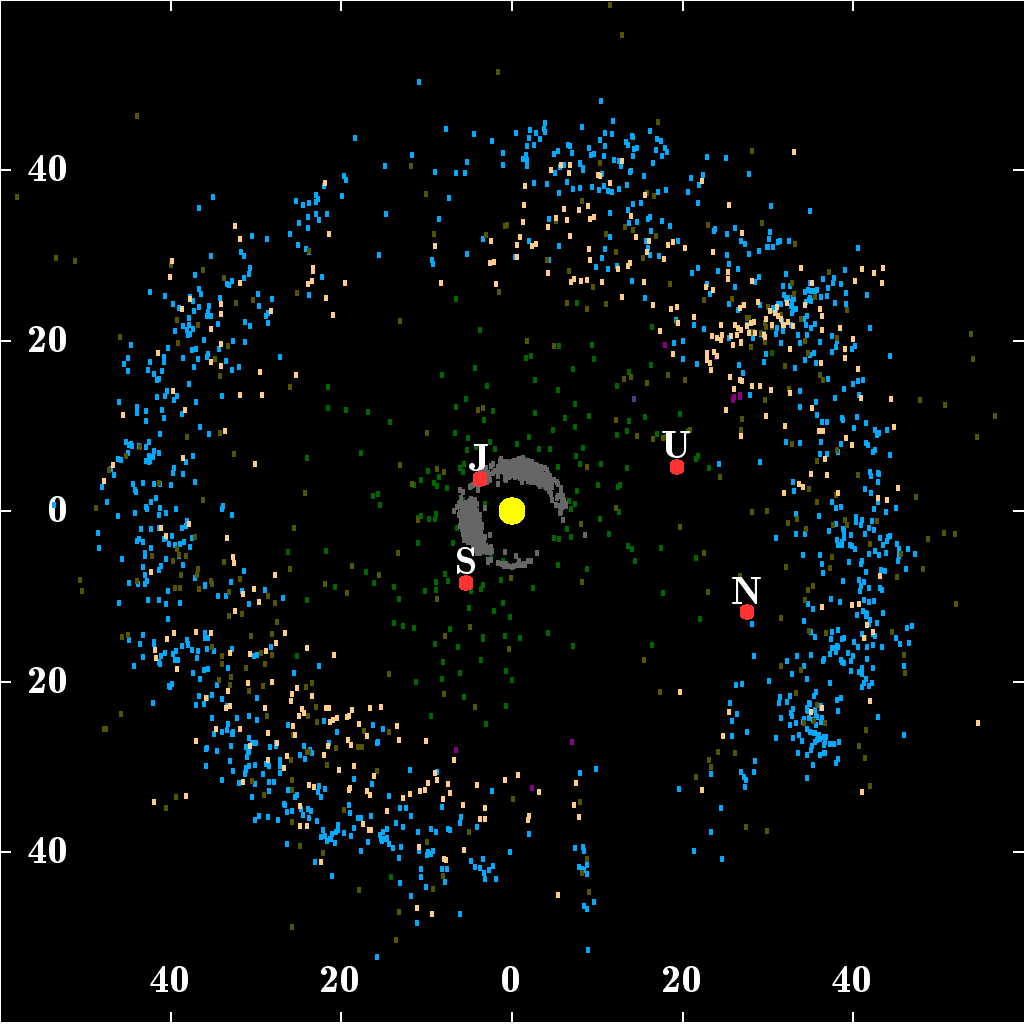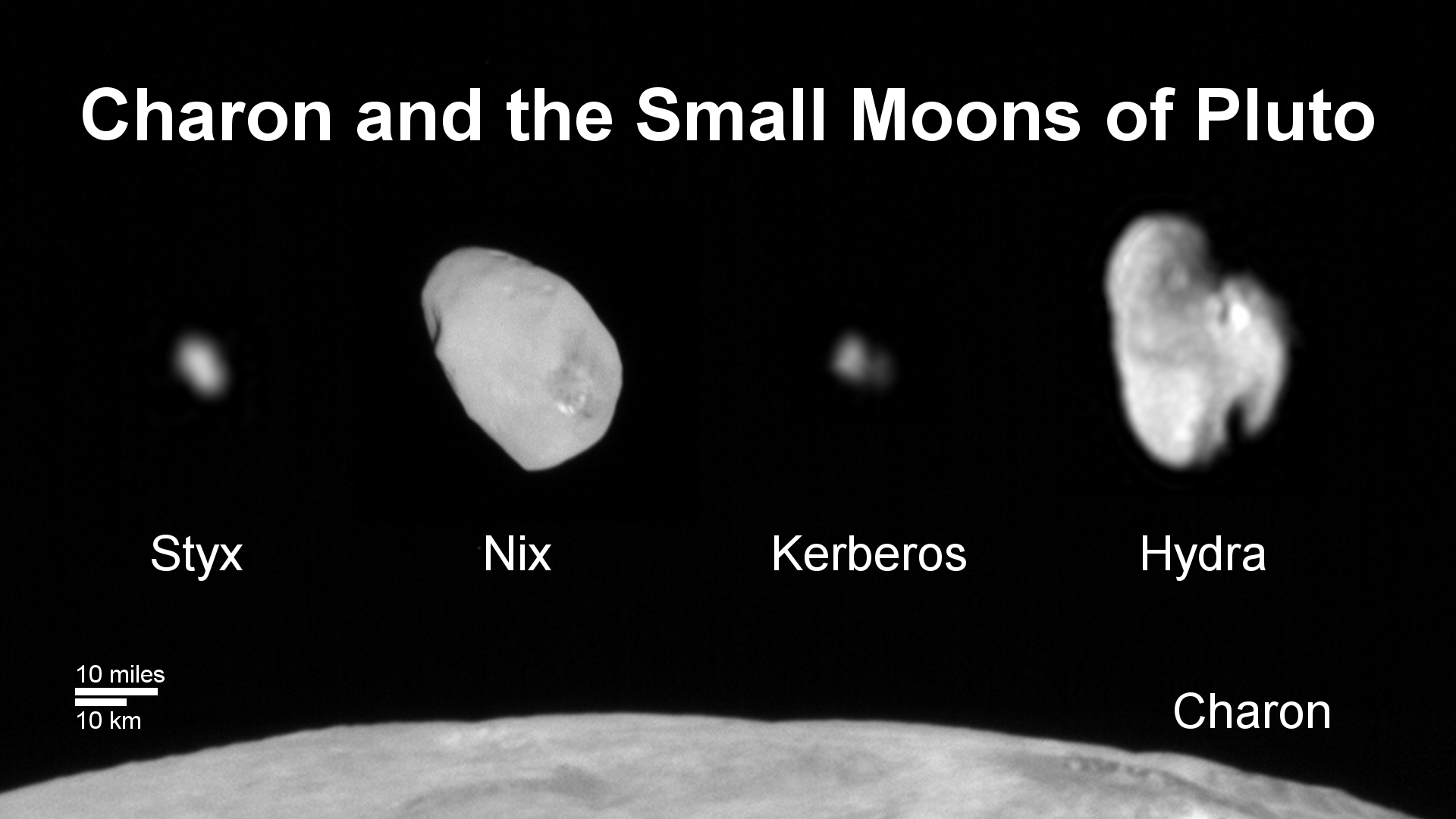|
Marc W. Buie
Marc William Buie (; born 1958) is an American astronomer and prolific discoverer of minor planets who works at the Southwest Research Institute in Boulder, Colorado in the Space Science Department. Formerly he worked at the Lowell Observatory in Flagstaff, Arizona, and was the Sentinel Space Telescope Mission Scientist for the B612 Foundation, which is dedicated to protecting Earth from asteroid impact events. Early life and education Buie grew up in Baton Rouge, Louisiana, and received his B.Sc. in physics from Louisiana State University in 1980. He then switched fields and earned his Ph.D. in Planetary Science from the University of Arizona in 1984. Buie was a post-doctoral fellow at the University of Hawaii from 1985 to 1988. From 1988 to 1991, he worked at the Space Telescope Science Institute where he played a key role in the planning and scheduling of the first planetary observations ever made by the Hubble Space Telescope. Buie joined the staff at Lowell Observatory ... [...More Info...] [...Related Items...] OR: [Wikipedia] [Google] [Baidu] |
United States
The United States of America (U.S.A. or USA), commonly known as the United States (U.S. or US) or America, is a country primarily located in North America. It consists of 50 states, a federal district, five major unincorporated territories, nine Minor Outlying Islands, and 326 Indian reservations. The United States is also in free association with three Pacific Island sovereign states: the Federated States of Micronesia, the Marshall Islands, and the Republic of Palau. It is the world's third-largest country by both land and total area. It shares land borders with Canada to its north and with Mexico to its south and has maritime borders with the Bahamas, Cuba, Russia, and other nations. With a population of over 333 million, it is the most populous country in the Americas and the third most populous in the world. The national capital of the United States is Washington, D.C. and its most populous city and principal financial center is New York City. Paleo-Americ ... [...More Info...] [...Related Items...] OR: [Wikipedia] [Google] [Baidu] |
Pluto
Pluto (minor-planet designation: 134340 Pluto) is a dwarf planet in the Kuiper belt, a ring of trans-Neptunian object, bodies beyond the orbit of Neptune. It is the ninth-largest and tenth-most-massive known object to directly orbit the Sun. It is the largest known trans-Neptunian object by volume, by a small margin, but is slightly less massive than Eris (dwarf planet), Eris. Like other Kuiper belt objects, Pluto is made primarily of ice and rock and is much smaller than the inner planets. Compared to Moon, Earth's moon, Pluto has only one sixth its mass and one third its volume. Pluto has a moderately orbital eccentricity, eccentric and inclined orbit, ranging from from the Sun. Light from the Sun takes 5.5 hours to reach Pluto at its average distance (). Pluto's eccentric orbit periodically brings it closer to the Sun than Neptune, but a stable orbital resonance prevents them from colliding. Pluto has moons of Pluto, five known moons: Charon (moon), Charon, the larg ... [...More Info...] [...Related Items...] OR: [Wikipedia] [Google] [Baidu] |
The Planetary Society
The Planetary Society is an American internationally-active non-governmental nonprofit organization. It is involved in research, public outreach, and political space advocacy Space advocacy is supporting or advocating for a human use of outer space. Purposes advocated can reach from space exploration, or commercial use of space to even space settlement. There are many different individuals and organizations dedicat ... for engineering projects related to astronomy, planetary science, and space exploration. It was founded in 1980 by Carl Sagan, Bruce C. Murray, Bruce Murray, and Louis Friedman, and has about 60,000 members from more than 100 countries around the world. The Society is dedicated to the exploration of the Solar System, the search for near-Earth objects, and the search for extraterrestrial life. The society's mission is stated as: "Empowering the world’s citizens to advance space science and exploration." The Planetary Society is a strong advocate for space ... [...More Info...] [...Related Items...] OR: [Wikipedia] [Google] [Baidu] |
New Horizons KBO Search
''New Horizons'' is an interplanetary space probe that was launched as a part of NASA's New Frontiers program. Engineered by the Johns Hopkins University Applied Physics Laboratory (APL) and the Southwest Research Institute (SwRI), with a team led by Alan Stern, the spacecraft was launched in 2006 with the primary mission to perform a flyby study of the Pluto system in 2015, and a secondary mission to fly by and study one or more other Kuiper belt objects (KBOs) in the decade to follow, which became a mission to 486958 Arrokoth. It is the fifth space probe to achieve the escape velocity needed to leave the Solar System. On January 19, 2006, ''New Horizons'' was launched from Cape Canaveral Space Force Station by an Atlas V rocket directly into an Earth-and-solar escape trajectory with a speed of about . It was the fastest (average speed with respect to Earth) man-made object ever launched from Earth. It is not the fastest speed recorded for a spacecraft, which as of 2021 ... [...More Info...] [...Related Items...] OR: [Wikipedia] [Google] [Baidu] |
New Horizons
''New Horizons'' is an Interplanetary spaceflight, interplanetary space probe that was launched as a part of NASA's New Frontiers program. Engineered by the Johns Hopkins University Applied Physics Laboratory (APL) and the Southwest Research Institute (SwRI), with a team led by Alan Stern, the spacecraft was launched in 2006 with the primary mission to perform a Planetary flyby, flyby study of the Pluto system in 2015, and a secondary mission to fly by and study one or more other Kuiper belt objects (KBOs) in the decade to follow, which became a mission to 486958 Arrokoth. It is the List of artificial objects leaving the Solar System, fifth space probe to achieve the escape velocity needed to leave the Solar System. On January 19, 2006, ''New Horizons'' was launched from Cape Canaveral Space Force Station by an Atlas V rocket directly into an Earth-and-solar Escape velocity, escape trajectory with a speed of about . It was the fastest (average speed with respect to Earth) man ... [...More Info...] [...Related Items...] OR: [Wikipedia] [Google] [Baidu] |
NASA
The National Aeronautics and Space Administration (NASA ) is an independent agency of the US federal government responsible for the civil space program, aeronautics research, and space research. NASA was established in 1958, succeeding the National Advisory Committee for Aeronautics (NACA), to give the U.S. space development effort a distinctly civilian orientation, emphasizing peaceful applications in space science. NASA has since led most American space exploration, including Project Mercury, Project Gemini, the 1968-1972 Apollo Moon landing missions, the Skylab space station, and the Space Shuttle. NASA supports the International Space Station and oversees the development of the Orion spacecraft and the Space Launch System for the crewed lunar Artemis program, Commercial Crew spacecraft, and the planned Lunar Gateway space station. The agency is also responsible for the Launch Services Program, which provides oversight of launch operations and countdown management f ... [...More Info...] [...Related Items...] OR: [Wikipedia] [Google] [Baidu] |
Kuiper Belt
The Kuiper belt () is a circumstellar disc in the outer Solar System, extending from the orbit of Neptune at 30 astronomical units (AU) to approximately 50 AU from the Sun. It is similar to the asteroid belt, but is far larger—20 times as wide and 20–200 times as massive. Like the asteroid belt, it consists mainly of small bodies or remnants from when the Solar System formed. While many asteroids are composed primarily of rock and metal, most Kuiper belt objects are composed largely of frozen volatiles (termed "ices"), such as methane, ammonia, and water. The Kuiper belt is home to most of the objects that astronomers generally accept as dwarf planets: Orcus, Pluto, Haumea, Quaoar, and Makemake. Some of the Solar System's moons, such as Neptune's Triton and Saturn's Phoebe, may have originated in the region. The Kuiper belt was named after Dutch astronomer Gerard Kuiper, although he did not predict its existence. In 1992, minor planet (15760) Albion was ... [...More Info...] [...Related Items...] OR: [Wikipedia] [Google] [Baidu] |
Deep Ecliptic Survey
The Deep Ecliptic Survey (DES) is a project to find Kuiper belt objects (KBOs), using the facilities of the National Optical Astronomy Observatory (NOAO). The principal investigator is Robert L. Millis. Since 1998 through the end of 2003, the survey covered 550 square degrees with Apparent magnitude, sensitivity of 22.5, which means an estimated 50% of objects of this magnitude have been found. The survey has also established the mean Kuiper Belt plane and introduced new cubewano#Toward a formal definition, formal definitions of the dynamical classes of Kuiper belt objects. The remarkable first observations and/or discoveries include: * 28978 Ixion, large plutino * 19521 Chaos (cubewano) * , the first Binary asteroid, binary trans-Neptunian object (TNO) * , the first object with perihelion too far to be affected (scattered) by Neptune and a large semi-major axis * , remarkable for its semi-major axis of more than 500 astronomical unit, AU and extreme orbital eccentricity, eccentr ... [...More Info...] [...Related Items...] OR: [Wikipedia] [Google] [Baidu] |
Marc Buie At Comodoro Rivadavia, Argentina
Marc or MARC may refer to: People * Marc (given name), people with the first name * Marc (surname), people with the family name Acronyms * MARC standards, a data format used for library cataloging, * MARC Train, a regional commuter rail system of the State of Maryland, serving Maryland, Washington, D.C., and eastern West Virginia * MARC (archive), a computer-related mailing list archive * M/A/R/C Research, a marketing research and consulting firm * Massachusetts Animal Rights Coalition, a non-profit, volunteer organization * Matador Automatic Radar Control, a guidance system for the Martin MGM-1 Matador cruise missile * Mid-America Regional Council, the Council of Governments and the Metropolitan Planning Organization for the bistate Kansas City region * Midwest Association for Race Cars, a former American stock car racing organization * Revolutionary Agrarian Movement of the Bolivian Peasantry (''Movimiento Agrario Revolucionario del Campesinado Boliviano''), a defunct right-wi ... [...More Info...] [...Related Items...] OR: [Wikipedia] [Google] [Baidu] |
Hydra (moon)
Hydra is a natural satellite of Pluto, with a diameter of approximately across its longest dimension. It is the second-largest moon of Pluto, being slightly larger than Nix. Hydra was discovered along with Nix by astronomers using the Hubble Space Telescope on 15 May 2005, and was named after the Hydra, the nine-headed underworld serpent in Greek mythology. By distance, Hydra is the fifth and outermost moon of Pluto, orbiting beyond Pluto's fourth moon Kerberos. Hydra has a highly reflective surface caused by the presence of water ice, similar to other Plutonian moons. Hydra's reflectivity is intermediate, in between those of Pluto and Charon. The ''New Horizons'' spacecraft imaged Pluto and its moons in July 2015 and returned multiple images of Hydra. Discovery Hydra was discovered by researchers of the Pluto Companion Search Team, consisting of Hal A. Weaver and many others involved in the ''New Horizons'' mission to Pluto, including Alan Stern and Marc W. Buie. ... [...More Info...] [...Related Items...] OR: [Wikipedia] [Google] [Baidu] |
Nix (moon)
Nix is a natural satellite of Pluto, with a diameter of across its longest dimension. It was discovered along with Pluto's outermost moon Hydra on 15 May 2005 by astronomers using the Hubble Space Telescope, and was named after Nyx, the Greek goddess of the night. Nix is the third moon of Pluto by distance, orbiting between the moons Styx and Kerberos. Nix was imaged along with Pluto and its other moons by the ''New Horizons'' spacecraft as it flew by the Pluto system in July 2015. Images from the ''New Horizons'' spacecraft reveal a large reddish area on Nix that is likely an impact crater. Discovery Nix was discovered by researchers of the Pluto Companion Search Team, using the Hubble Space Telescope. The ''New Horizons'' team had suspected that Pluto and its moon Charon might be accompanied with other moons, hence they used the Hubble Space Telescope to search for faint moons around Pluto in 2005. Since Nix's brightness is about 5,000 times fainter than Pluto, ... [...More Info...] [...Related Items...] OR: [Wikipedia] [Google] [Baidu] |
Moons Of Pluto
The dwarf planet Pluto has five natural satellites. In order of distance from Pluto, they are Charon (moon), Charon, Styx (moon), Styx, Nix (moon), Nix, Kerberos (moon), Kerberos, and Hydra (moon), Hydra. Charon, the largest, is mutually tidally locked with Pluto, and is massive enough that Pluto–Charon is sometimes considered a Double planet, double dwarf planet. History The innermost and largest moon, Charon (moon), Charon, was discovered by James Christy on 22 June 1978, nearly half a century after Pluto was discovered. This led to a substantial revision in estimates of Pluto's size, which had previously assumed that the observed mass and reflected light of the system were all attributable to Pluto alone. Two additional moons were imaged by astronomers of the Pluto Companion Search Team preparing for the ''New Horizons'' mission and working with the Hubble Space Telescope on 15 May 2005, which received the Provisional designation in astronomy, provisional designations S/2005 ... [...More Info...] [...Related Items...] OR: [Wikipedia] [Google] [Baidu] |



.jpg)


.jpg)
